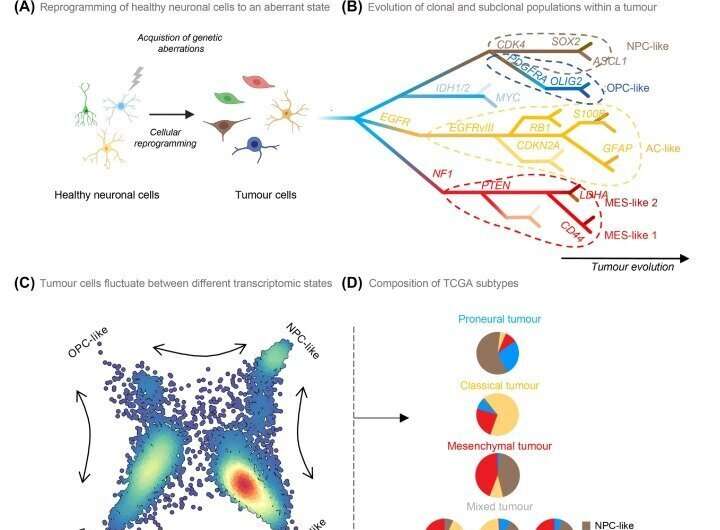
Understanding how cancer cells evolve from healthy brain cells and evade treatment could open up potential new drug therapies for glioblastomas, one of the most common and lethal brain cancers, new research has revealed.
By bringing together neuroscience and oncology, the team from Flinders University and the South Australian Health and Medical Research Institute (SAHMRI) is hopeful of finding a new method to treat the deadly disease.
“Glioblastomas can affect anyone and only 5% of patients survive more than 5 years following their diagnosis,” says study senior author Associate Professor Cedric Bardy from Flinders University and Group Leader of SAHMRI’s Laboratory for Human Neurophysiology and Genetics.
“A major therapeutic challenge is the variability and adaptability of these brain tumor cells. From patient to patient, glioblastoma tumors are composed of several types of cells in varying proportions. It’s these variations and their incredible capacity to quickly change their identity to hide and escape treatments that make them challenging to eradicate.”
“However, recent advances in genetics have shown that the cell types found within glioblastomas maintain some resemblance to the cells of origin, before they became cancerous, and use molecular pathways common with brain cells for growth and survival or when changing their identity.”
In a new study, published in Trends in Cancer, the team explore these similarities and differences in a bid to shed light on the potential pathways used by tumor cells to escape treatment.
“What our research suggests is that we may learn from the genetics of healthy brain cells in order to target vulnerabilities in glioblastoma cancer cells,” says study lead author Inushi De Silva, a Ph.D. student with Flinders University and SAHMRI.
“Brain cells are not as good as cancer cells in being able to quickly change their identity in response to environmental changes, so if we manage to exploit and amplify this hidden inherited genetic weakness in cancer cells, we might be able to reverse their ability to escape treatments.”
The authors say despite cancer cells having an immense ability to change and hide, the research shows they still evolve along known brain pathways.
“We should be able to use this in targeted therapy, with treatments that restrict glioblastoma tumor cells ability to change, known as plasticity. Understanding more about these mechanisms will be helpful to develop new treatments in the future,” says Associate Professor Bardy.
“Glioblastoma cells are tough to kill because they are such a fast-moving target. This review helps us understand the different pathways in which they can hide. If we can block them in a corner, we may have a better chance to hit the target and cure this terrible disease.”
Source: Read Full Article